Computación Estadística con R
Manipulación de Datos
Joshua Kunst
Manejo de Datos
Antes el %>%
Ir a RStudio. Yay!
Importar datos
## # A tibble: 6 x 4
## storm wind pressure date
## <chr> <dbl> <dbl> <date>
## 1 Alberto 110 1007 2000-08-03
## 2 Alex 45 1009 1998-07-27
## 3 Allison 65 1005 1995-06-03
## 4 Ana 40 1013 1997-06-30
## 5 Arlene 50 1010 1999-06-11
## 6 Arthur 45 1010 1996-06-17## # A tibble: 6 x 3
## city size amount
## <chr> <chr> <dbl>
## 1 New York large 23
## 2 New York small 14
## 3 London large 22
## 4 London small 16
## 5 Beijing large 121
## 6 Beijing small 56filter Seleccionar Filas

filter Ejemplo

filter Código
filter(storms, storm %in% c("Alberto", "Ana"))## # A tibble: 2 x 4
## storm wind pressure date
## <chr> <dbl> <dbl> <date>
## 1 Alberto 110 1007 2000-08-03
## 2 Ana 40 1013 1997-06-30select Seleccionar Columnas

select Ejemplo
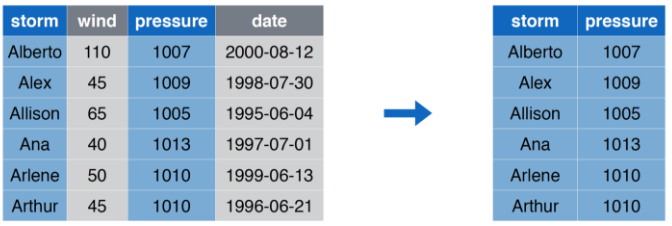
select Código
select(storms, storm, pressure)## # A tibble: 6 x 2
## storm pressure
## <chr> <dbl>
## 1 Alberto 1007
## 2 Alex 1009
## 3 Allison 1005
## 4 Ana 1013
## 5 Arlene 1010
## 6 Arthur 1010Versión alternativa
## # A tibble: 6 x 2
## storm pressure
## <chr> <dbl>
## 1 Alberto 1007
## 2 Alex 1009
## 3 Allison 1005
## 4 Ana 1013
## 5 Arlene 1010
## 6 Arthur 1010arrange Ordenar Filas

arrange Ejemplo

arrange Código
arrange(storms, wind)## # A tibble: 6 x 4
## storm wind pressure date
## <chr> <dbl> <dbl> <date>
## 1 Ana 40 1013 1997-06-30
## 2 Alex 45 1009 1998-07-27
## 3 Arthur 45 1010 1996-06-17
## 4 Arlene 50 1010 1999-06-11
## 5 Allison 65 1005 1995-06-03
## 6 Alberto 110 1007 2000-08-03mutate Crear/Modificar columnas

mutate Ejemplo

mutate Código
mutate(storms, ratio = pressure/wind, inverse = 1/ratio)## # A tibble: 6 x 6
## storm wind pressure date ratio inverse
## <chr> <dbl> <dbl> <date> <dbl> <dbl>
## 1 Alberto 110 1007 2000-08-03 9.15 0.109
## 2 Alex 45 1009 1998-07-27 22.4 0.0446
## 3 Allison 65 1005 1995-06-03 15.5 0.0647
## 4 Ana 40 1013 1997-06-30 25.3 0.0395
## 5 Arlene 50 1010 1999-06-11 20.2 0.0495
## 6 Arthur 45 1010 1996-06-17 22.4 0.0446summarize Resumir Columnas
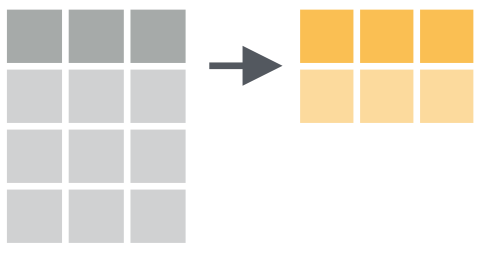
summarize Ejemplo

summarise Código
summarise(pollution, median = median(amount))## # A tibble: 1 x 1
## median
## <dbl>
## 1 22.5group_by + summarize Resumir Columnas por Grupos

group_by + summarize Ejemplo
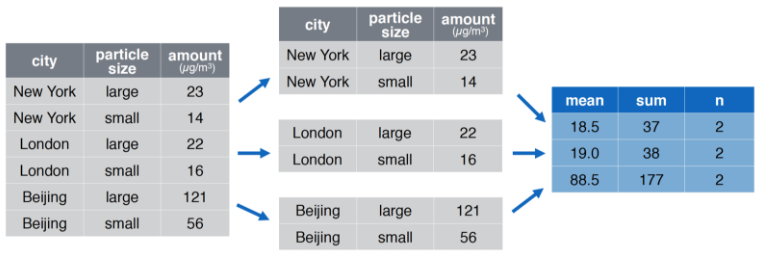
group_by + summarise Código
pollution %>%
group_by(city) %>%
summarise(
promedio = median(amount),
suma = sum(amount),
n = n()
)## # A tibble: 3 x 4
## city promedio suma n
## <chr> <dbl> <dbl> <int>
## 1 Beijing 88.5 177 2
## 2 London 19 38 2
## 3 New York 18.5 37 2Ejercicios
Revisemos el archivo 03-script-manipulacion-datos-01.R
Con el archivo de http://datos.gob.cl/dataset/28198
- ¿Cuatos registros y filas tiene la tabla?
- ¿Cual es la comuna con mas puntos BIP!?
- ¿Cual es la entidad/comuna menos repetida?
- ¿Cuantos centros BIP existen en La Florida?
Manejo de Datos 2
Importar datos
## # A tibble: 4 x 2
## song name
## <chr> <chr>
## 1 Across the Universe John
## 2 Come Together John
## 3 Hello, Goodbye Paul
## 4 Peggy Sue Buddy## # A tibble: 4 x 2
## name plays
## <chr> <chr>
## 1 George sitar
## 2 John guitar
## 3 Paul bass
## 4 Ringo drumsleft_join Juntar tablas
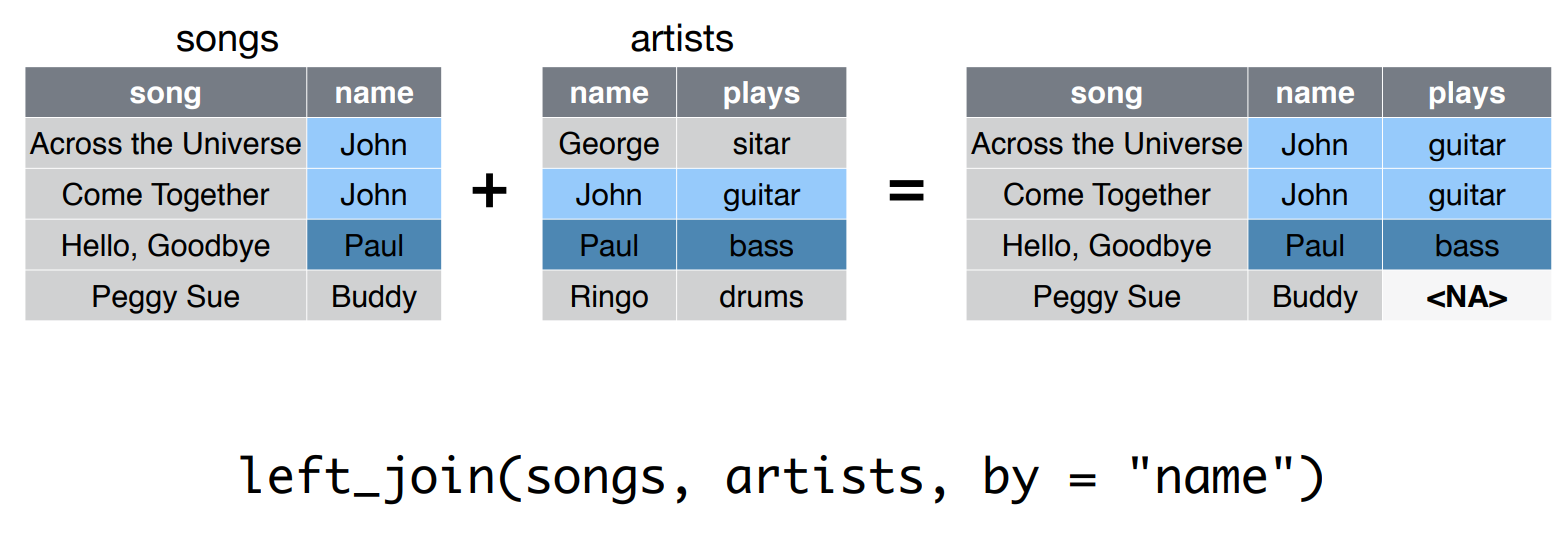
left_join Código
## # A tibble: 4 x 3
## song name plays
## <chr> <chr> <chr>
## 1 Across the Universe John guitar
## 2 Come Together John guitar
## 3 Hello, Goodbye Paul bass
## 4 Peggy Sue Buddy <NA>Importar datos 2
## # A tibble: 3 x 3
## country `1999` `2000`
## * <chr> <int> <int>
## 1 Afghanistan 745 2666
## 2 Brazil 37737 80488
## 3 China 212258 213766## # A tibble: 12 x 4
## country year type count
## <chr> <int> <chr> <int>
## 1 Afghanistan 1999 cases 745
## 2 Afghanistan 1999 population 19987071
## 3 Afghanistan 2000 cases 2666
## 4 Afghanistan 2000 population 20595360
## 5 Brazil 1999 cases 37737
## 6 Brazil 1999 population 172006362
## 7 Brazil 2000 cases 80488
## 8 Brazil 2000 population 174504898
## 9 China 1999 cases 212258
## 10 China 1999 population 1272915272
## 11 China 2000 cases 213766
## 12 China 2000 population 1280428583## # A tibble: 3 x 4
## country `2011` `2012` `2013`
## <chr> <dbl> <dbl> <dbl>
## 1 FR 7000 6900 7000
## 2 DE 5800 6000 6200
## 3 US 15000 14000 13000¿Como obtendríamos el promedio por país?
¿Como obtendríamos el promedio por país?
## # A tibble: 3 x 5
## country `2011` `2012` `2013` promedio
## <chr> <dbl> <dbl> <dbl> <dbl>
## 1 FR 7000 6900 7000 6967.
## 2 DE 5800 6000 6200 6000
## 3 US 15000 14000 13000 14000Ahora pensemos en una tabla más grande, con más años
gather Recolectar
Coloca nombres de columnas en una variable (columna) key, recolectando los valores (value) de las columnas en un sola columna
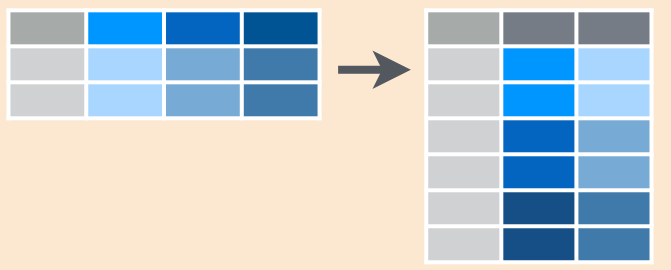
gather Ejemplo

gather Código
## # A tibble: 6 x 3
## country year cases
## <chr> <chr> <int>
## 1 Afghanistan 1999 745
## 2 Brazil 1999 37737
## 3 China 1999 212258
## 4 Afghanistan 2000 2666
## 5 Brazil 2000 80488
## 6 China 2000 213766spread Esparcir
Esparce un par de columnas (2, key-value) en multiples columnas

spread Ejemplo
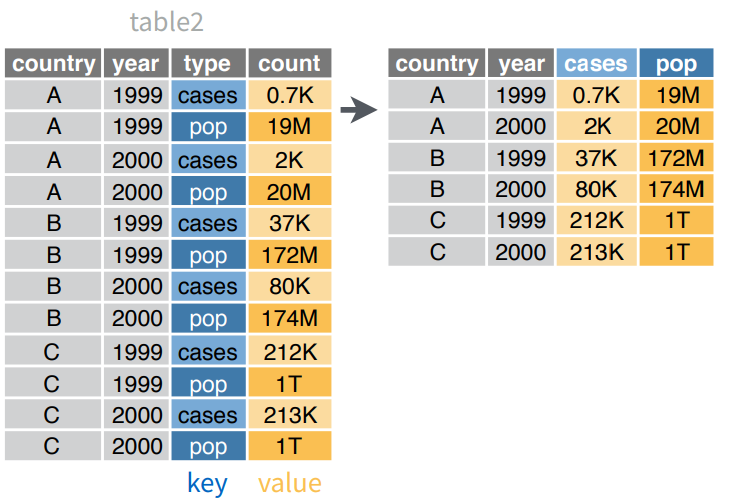
spread Código
## # A tibble: 6 x 4
## country year cases population
## <chr> <int> <int> <int>
## 1 Afghanistan 1999 745 19987071
## 2 Afghanistan 2000 2666 20595360
## 3 Brazil 1999 37737 172006362
## 4 Brazil 2000 80488 174504898
## 5 China 1999 212258 1272915272
## 6 China 2000 213766 1280428583Ejercicios
Revisemos el archivo 03-script-manipulacion-datos-02.R